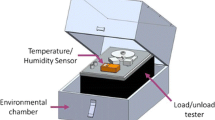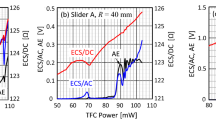Abstract
Contact between a thermal flying height control slider and an asperity on a disk is investigated using finite element analysis. The finite element model developed accounts for transient elastic–plastic deformation and heat generation due to frictional heating. Plastic deformation and temperature rise of the read/write element are determined as a function of flying height of the slider, location of the read/write element as well as material properties of typical disk asperities. The model shows good agreement with experimental data. Significant plastic deformation and temperature rise were observed in the shield and alumina regions of the slider. Hard and stiff disk asperities, such as alumina asperities, result in more damage to the slider than soft and compliant nickel-phosphorus ones.














Similar content being viewed by others
References
Block H (1937) Theoretical study of temperature rise at surfaces of actual contact under oiliness lubricating conditions. Proc Inst Mech Eng Gen Discuss Lubr 2:222–235
Dorfman V, Wolf JK (2001) A method for reducing the effects of thermal asperities. IEEE Trans Magn 19(4):662–667
Erden MF, Kurtas EM (2004) Thermal asperity detection and cancellation in perpendicular magnetic recording systems. IEEE Trans Magn 40(3):1732–1737
Hallquist JO (2006) LS-DYNA theoretical manual. Livermore Software Technology Corporation, Livermore
Johnson KL (1985) Contact mechanics. Cambridge University Press, Cambridge
Kools JCS (1996) Exchange-biased spin-valves for magnetic storage. IEEE Trans Magn 32(4):3165–3184
Kurita M, Xu J, Tokuyama M, Nakamoto K, Saegusa S, Maruyama Y (2005) Flying-height reduction of magnetic-head slider due to thermal protrusion. IEEE Trans Magn 41(10):3007–3009
Li H, Zheng H, Fritzsche J, Amemoya K, Talke FE (2010) Simulation of flying height and response time of thermal flying height control sliders with thermal insulators. IEEE Trans Magn 46(6):1292–1294
Mathew G, Tjhia I (2005) Thermal asperity suppression in perpendicular recording channels. IEEE Trans Magn 41(10):2878–2880
Nogues J, Schuller IK (1999) Exchange bias. J Magn and Magn Mat 192:203–232
Ovcharenko A, Yang M, Chun K, Talke FE (2010) Simulation of magnetic erasure due to transient slider-disk contacts. IEEE Trans Magn 46(3):770–777
Ovcharenko A, Yang M, Chun K, Talke FE (2011) Transient thermomechanical contact of an impacting sphere on a moving flat. ASME J Tribol 133:031404
Pinarbasi M, Metin S, Gill H, Parker M, Gurney B, Carey M, Tsang C (2000) Antiparallel pinned NiO spin valve sensor for GMR head application. J Appl Phys 87(9):5714–5719
Sharma V, Kim SH, Choa SH (2001a) Head and media design considerations for reducing thermal asperity. Tribol Int 34(5):307–314
Sharma V, Kim SH, Choa SH (2001b) The effects of slider design on thermal asperity rejection capability. J Mech Sci Technol 15(3):281–290
Stupp SE, Baldwinson MA, Mcewen P (1999) Thermal asperity trends. IEEE Trans Magn 35(2):752–757
Suzuki S, Kennedy FE (1989) Measurement of flash temperature and contact between slider and magnetic recording disk. IEEE Trans Magn 25(5):3728–3730
Tian X, Kennedy FE (1994) Maximum and average flash temperatures in sliding contacts. ASME J Tribol 116(1):167–174
Yu N, Polycarpou AA, Hanchi JV (2008) Elastic contact mechanics-based contact and flash temperature analysis of impact-induced head disk interface damage. Microsyst Technol 14(2):215–227
Yuan Z, Liu B (2000) Anti-thermal asperity head: design and performance analysis. J Magn Magn Mater 209(1–3):166–168
Zheng H, Li H, Talke FE (2009) Numerical simulation of a thermal flying height control slider with dual heater and insulator elements. IEEE Trans Magn 45(10):3628–3631
Acknowledgments
We would like to thank Dr. Raj Thangaraj, Dr. John Ji and Dr. Leo Volpe from Western Digital Corporation for helpful discussions with this paper. Wenping Song thanks the China Scholarship Council (CSC) and Prof. Guangyu Zhang from Harbin Institute of Technology, for supporting his Ph.D. studies at UCSD.
Author information
Authors and Affiliations
Corresponding author
Rights and permissions
About this article
Cite this article
Song, W., Ovcharenko, A., Yang, M. et al. Contact between a thermal flying height control slider and a disk asperity. Microsyst Technol 18, 1549–1557 (2012). https://doi.org/10.1007/s00542-012-1591-0
Received:
Accepted:
Published:
Issue Date:
DOI: https://doi.org/10.1007/s00542-012-1591-0




